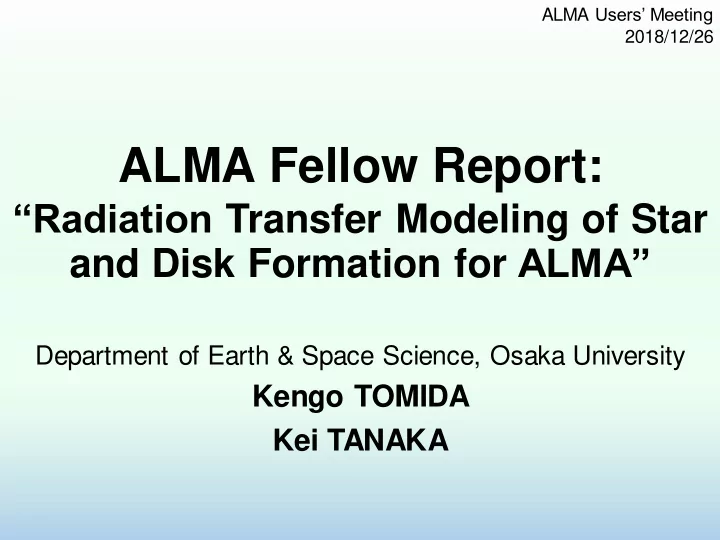

ALMA Users’ Meeting 2018/12/26 ALMA Fellow Report: “Radiation Transfer Modeling of Star and Disk Formation for ALMA” Department of Earth & Space Science, Osaka University Kengo TOMIDA Kei TANAKA
The Goal of Our Project • Develop a post-processing radiation transfer code based on the Athena++ framework for synthetic observations (mainly) for ALMA • Use synthetic observations for proposing and interpreting observations of star and disk formation • Bridge the gap between observations and simulations to understand star/disk formation more quantitatively This is a half theory, half observation project. (Athena++: a public astrophysical MHD code we are developing.)
The First Year Achievements The Project started from January 1st, 2018. 1. ALMA Cycle-6 proposals 2. Theoretical models for massive star formation 3. Collaboration with observers 4. RT code development (in progress)
Cycle-6 Proposals We submitted 2 PI proposals and 16 (incl. 2 LP) Co-I proposals. Both PI proposals are accepted (for the first time for both of us). 1. Tanaka et al. 2018.1.01656.S, “Resolving the Accretion Disk with Photoionized Outflow in O- Star Formation” (Grade B) 2. Tomida et al. 2018.1.01389.S, “Mapping Magnetic Fields in the Molecular Cloud Cores Harboring Class-0 Objects” (Grade C) Also, 5 Co-I proposals are accepted. (Feel free to call us observers.)
Photo-Ionized Outflows (Tanaka+) Top-left: Our target. High resolution imaging is proposed toward the protostar Top-right: SED model and observations Bottom: Theoretical prediction. The spectral index map elucidates the outflow and disk structures. Goal: Reveal the radiation feedback and its effect on the disk. → Is massive star formation similar to low-mass star formation?
Based on Fujishiro- san’s senior thesis B-Fields at Core Scale (Tomida+) Hull+ Cycle-2 • Inclination produces complicated polarization patterns. • need large MRS rather than resolution to capture the core scale → quantify the significance of magnetic fields in star formation
(T anaka+ 2018, ApJ) Model for Massive Star Formation Semi-analytic prescription for star formation including various feedback processes in different environments • MHD wind is most significant even in massive star formation • Photoevaporation becomes effective in lower-metallicty environments, but does not set the upper mass limit.
Photo-evaporation from an O-star Zhang, Tanaka+ in prep. G45.47+0.05 Top: Observations of continuum with ALMA Band 6 and VLA Band Q Bottom: Theoretical models of continuum emission. The model can predict the properties of the massive protostar, such as flow velocity (~50km/s), outflow rate (3x10 -5 M s /yr), etc.
Disk + Outflow around a massive protostar G339.88-1.26 Zhang, T an, Sakai, T anaka+ submitted Multiple line observations (SiO, SO 2 , H 2 S, CH 3 OH, and H 2 CO) → Massive star formation is a scale-up version of low-mass SF
RT code development MHD simulation of molecular cloud Dust polarization simulation formation (Iwasaki+ 2019) As the first step for general radiation transfer code, we start from dust polarization RT simulation based on the Athena++ result. → Relation between magnetic fields and cloud structure
Summary 1. ALMA Cycle-6 proposals 2 PI proposals and 5 co-I proposals are accepted. 2. Theoretical models for massive star formation useful for estimating properties of massive YSOs 3. Collaboration with observers Providing theoretical models for observations 4. RT code development (in progress) Dust continuum in progress, line transfer will follow
Recommend
More recommend